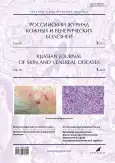Evaluation of the effectiveness of exosome therapy in patients with androgenetic alopecia: case series
- Authors: Lepekhova A.A.1, Olisova O.Y.1, Smolyannikova V.A.1, Grekova E.V.1, Karray K.1
-
Affiliations:
- The First Sechenov Moscow State Medical University (Sechenov University)
- Issue: Vol 28, No 3 (2025)
- Pages: 240-248
- Section: DERMATOLOGY
- URL: https://journal-vniispk.ru/1560-9588/article/view/313071
- DOI: https://doi.org/10.17816/dv646265
- EDN: https://elibrary.ru/ZWHDDH
- ID: 313071
Cite item
Abstract
Androgenetic alopecia is a genetically determined, multifactorial disorder characterized by the miniaturization of terminal hair into pathologically thinned vellus hair, eventually leading to hair loss. Minoxidil and 5α-reductase inhibitors are considered first-line treatments for androgenetic alopecia; however, some patients experience adverse effects or show inadequate response to these therapies, necessitating the development of novel, effective, and safe treatment options.
Exosomes are small membrane-bound vesicles involved in intercellular communication. They can carry proteins, lipids, RNA, and growth factors that may promote prolongation of the anagen phase (growth phase), enhance microcirculation, and stimulate hair follicle regeneration.
This article presents two clinical cases of patients with mild to moderate androgenetic alopecia treated with a solution containing exosomes derived from salmon tissue. Phototrichogram data demonstrated a marked therapeutic benefit in both cases, including increased hair density (via higher anagen hair count) and reduced vellus hair proportion (from 21/12% to 10/8% and from 32/10% to 3/10% before and after treatment, respectively).
Keywords
Full Text
##article.viewOnOriginalSite##About the authors
Anfisa A. Lepekhova
The First Sechenov Moscow State Medical University (Sechenov University)
Author for correspondence.
Email: anfisa.lepehova@yandex.ru
ORCID iD: 0000-0002-4365-3090
SPIN-code: 3261-3520
MD, Cand. Sci. (Medicine), Associate Professor
Russian Federation, MoscowOlga Yu. Olisova
The First Sechenov Moscow State Medical University (Sechenov University)
Email: olisovaolga@mail.ru
ORCID iD: 0000-0003-2482-1754
SPIN-code: 2500-7989
MD, Dr. Sci. (Medicine), Professor, Corresponding Member of the Russian Academy of Sciences
Russian Federation, MoscowVera A. Smolyannikova
The First Sechenov Moscow State Medical University (Sechenov University)
Email: smva@bk.ru
ORCID iD: 0000-0002-7759-5378
SPIN-code: 1953-6595
MD, Dr. Sci. (Medicine), Professor
Russian Federation, MoscowEkaterina V. Grekova
The First Sechenov Moscow State Medical University (Sechenov University)
Email: grekova_kate@mail.ru
ORCID iD: 0000-0002-7968-9829
SPIN-code: 8028-5545
MD, Cand. Sci. (Medicine), Associate Professor
Russian Federation, MoscowKarim Karray
The First Sechenov Moscow State Medical University (Sechenov University)
Email: karimkarray49@gmail.com
ORCID iD: 0009-0008-1143-7669
MD
Russian Federation, MoscowReferences
- Lee WS, Lee HJ. Characteristics of androgenetic alopecia in Asian. Ann Dermatol. 2012;24(3):243–252. doi: 10.5021/ad.2012.24.3.243
- Kaiser M, Abdin R, Gaumond SI, et al. Treatment of androgenetic alopecia: Current guidance and unmet needs. Clin Cosmet Investig Dermatol. 2023;16:1387–1406. doi: 10.2147/CCID.S385861
- Mao Y, Liu P, Wei J, et al. Cell therapy for androgenetic alopecia: Elixir or trick? Stem Cell Rev Rep. 2023;19(6):1785–1799. doi: 10.1007/s12015-023-10532-2
- Ersan M, Ozer E, Akin O, et al. Effectiveness of exosome treatment in androgenetic alopecia: Outcomes of a prospective study. Aesthetic Plast Surg. 2024;48(21):4262–4271. doi: 10.1007/s00266-024-04332-3
- Salman KE, Altunay IK, Kucukunal NA, et al. Frequency, severity and related factors of androgenetic alopecia in dermatology outpatient clinic: Hospital-based cross-sectional study in Turkey. An Bras Dermatol. 2017;92(1):35–40. doi: 10.1590/abd1806-4841.20175241
- McCoy J, Goren A, Kovacevic M, et al. Minoxidil dose response study in female pattern hair loss patients determined to be non-responders to 5% topical minoxidil. J Biol Regul Homeost Agents. 2016;30(4):1153–1155.
- Goren A, Shapiro J, Roberts J, et al. Clinical utility and validity of minoxidil response testing in androgenetic alopecia. Dermatol Ther. 2015;28(1):13–16. doi: 10.1111/dth.12164
- Kaiser MA, Almeida SM, Rodriguez M, et al. Low-level light therapy and minoxidil combination treatment in androgenetic alopecia: A review of the literature. Skin Appendage Disord. 2023;9(2):104–110. doi: 10.1159/000527782
- Feldman PR, Gentile P, Piwko C, et al. Hair regrowth treatment efficacy and resistance in androgenetic alopecia: A systematic review and continuous Bayesian network meta-analysis. Front Med (Lausanne). 2023;9:998623. doi: 10.3389/fmed.2022.998623
- Li Y, Wang G, Wang Q, et al. Exosomes secreted from adipose-derived stem cells are a potential treatment agent for immune-mediated alopecia. J Immunol Res. 2022;2022:7471246. doi: 10.1155/2022/7471246
- Lin WH, Xiang LJ, Shi HX et al. Fibroblast growth factors stimulate hair growth through β-catenin and Shh expression in C57BL/6 mice. Biomed Res Int. 2015;2015:730139. doi: 10.1155/2015/730139
- Bitto A, Oteri G, Pisano M, et al. Adenosine receptor stimulation by polynucleotides (PDRN) reduces inflammation in experimental periodontitis. J Clin Periodontol. 2013;40(1):26–32. doi: 10.1111/jcpe.12010
- Adil A, Godwin M. The effectiveness of treatments for androgenetic alopecia: A systematic review and meta-analysis. J Am Acad Dermatol. 2017;77(1):136–141.e5. doi: 10.1016/j.jaad.2017.02.054
- Butt G, Hussain I, Ahmad FJ, Choudhery MS. Stromal vascular fraction-enriched platelet-rich plasma therapy reverses the effects of androgenetic alopecia. J Cosmet Dermatol. 2020;19(5):1078–1085. doi: 10.1111/jocd.13149
- Cavallini M, Bartoletti E, Maioli L, et al. Consensus report on the use of PN-HPT™ (polynucleotides highly purified technology) in aesthetic medicine. J Cosmet Dermatol. 2021;20(3):922–928. doi: 10.1111/jocd.13679
- Cheng M, Ma C, Chen HD, et al. The roles of exosomes in regulating hair follicle growth. Clin Cosmet Investig Dermatol. 2024;17:1603–1612. doi: 10.2147/CCID.S465963
- Gupta AK, Wang T, Rapaport JA. Systematic review of exosome treatment in hair restoration: Preliminary evidence, safety, and future directions. J Cosmet Dermatol. 2023;22(9):2424–2433. doi: 10.1111/jocd.15869
Supplementary files













